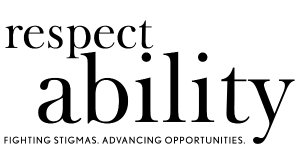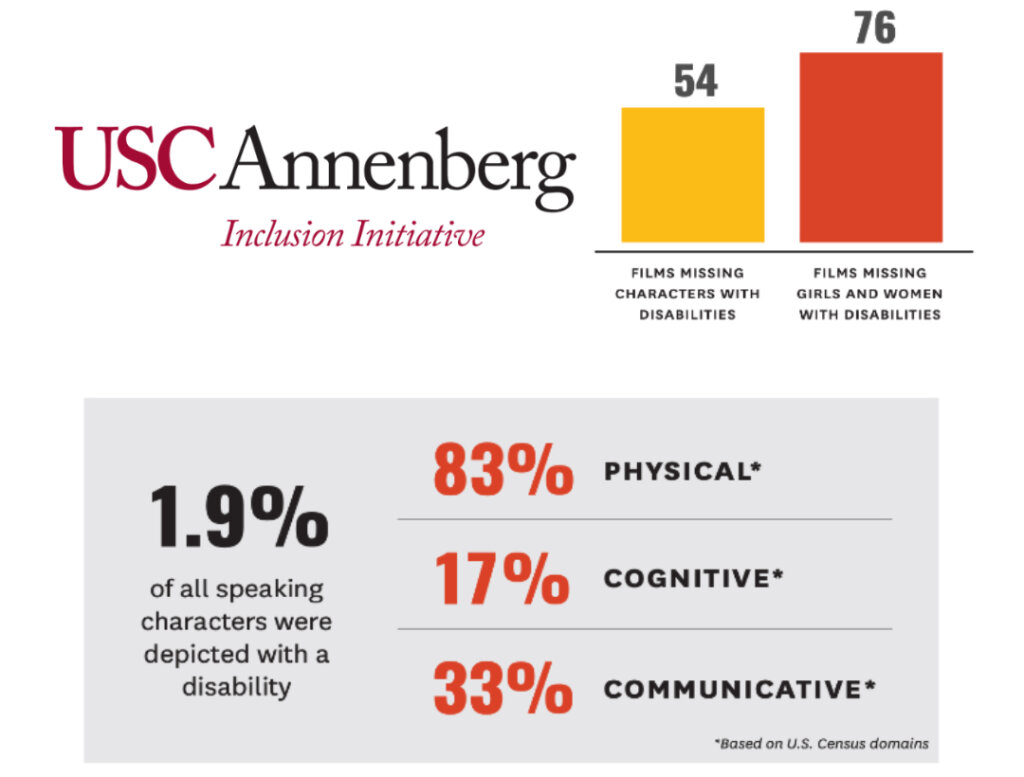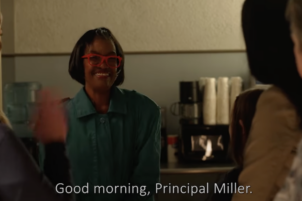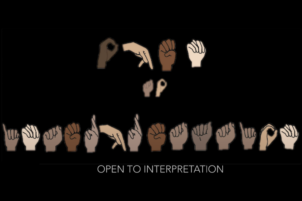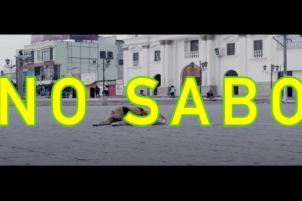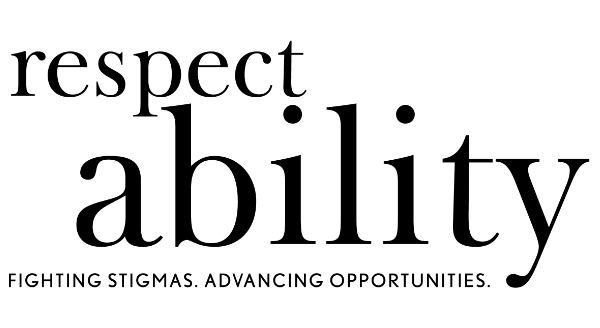27% of the U.S. population is disabled, yet only 1.9% of all speaking characters in 100 of the top-grossing films in 2022 were shown as disabled, according to USC Annenberg’s latest study on inequality in film.
Disability Is Intersectional
A breakdown of the intersecting identities of disabled characters in the top-grossing films in 2022, according to the study, shows a further mismatch between the makeup of the disability community and its representation on screen. The Annenberg study found that of the already small number of disabled characters in the top films of 2022, 69.1% were male-identifying, and only 30.9% were female-identifying. In addition to underrepresenting female-presenting disabled characters, the top films of 2022 also underrepresented nonwhite racial and ethnic groups. Only 24% of disabled characters in the films surveyed in 2022 were from a historically underrepresented racial or ethnic group. That means more than three-fourths of characters shown as disabled in the films surveyed in 2022 were white. Further, only 1 disabled character in all 100 movies surveyed from 2022 was shown as a member of the LGBTQIA+ community. Trans disability representation was found to be completely nonexistent.
Since the disability community is not monolithic, “part of proportional disability representation includes representing the diversity of the disability community and experience,” said Lauren Appelbaum, Senior Vice President of Entertainment and News Media at RespectAbility.
Representing the spectrum of the disability experience also requires filmmakers to include disabled people of all ages in their stories, a goal Hollywood has yet to reach. Annenberg’s study shows that in 2022, 59.7% of disabled characters in the top films were middle-aged or elderly (40 or older). This left teens and kids with the least representation, with teens representing only 2.6% of disabled characters in the top movies in 2022, and kids representing 6.5% of disabled characters. With kids and teens spending on average between 4-9 hours a day watching or using screens, according to the American Academy of Child and Adolescent Psychiatry, the stories shown on those screens and who is in them matter.
A report from Common Sense Media on “Why Representation Matters for Kids’ Ethnic-Racial Development” found that authentic racial representation shapes kids understanding of their own racial identities, as well as their understanding of others’ racial identities. This understanding affects how kids treat others of different racial backgrounds than their own. RespectAbility believes authentic disability representation can have the same effect on kids as authentic portrayals of people of color. That is why it is imperative to include disabled kids and teens in film and TV to portray the reality that disability affects people of all ages.
Authentic disability representation in films and television impacts not only how disabled people view themselves, but also how non-disabled folks view disabled people, leading to an advancement of opportunities and the removal of stigmas. Lawon Exum, RespectAbility’s Entertainment and News Media Director, emphasized that “when viewers don’t see disabled people on screen representing the lives that they lead off screen as nurses, parents, students, teachers, lawyers, CEOs, etcetera, then the public is misled to believe that disabled people can’t or don’t partake in society, effectively erasing 26% of the population”.
Disability Representation Over Time
In addition to reporting disability representation in the top films in 2022, the USC Annenberg study also compared the prevalence of disabled characters across 800 of the top-grossing films from 2015 to 2022. The minuscule 1.9% of disabled characters with dialogue in the top-grossing films in 2022 is a decrease from 2.1% in 2021. Across 8 years, there was no significant change in disability representation. Even more concerning, of the 800 films surveyed over eight years, only one film included disabled characters in proportion to the 27% of the population that disabled people represent.
Disabled Leads/Co-Leads
The majority of the information in the study was based on either speaking characters or disabled characters with unidentified roles. However, the study did briefly mention the percentage of disabled leads and co-leads over the years. Out of the 100 top-grossing films in 2022, 14 had leads or co-leads depicted with a disability. And out of those 14, 11 were male and only 3 were female. Whilst this was a slight increase from the 9 leads or co-leads depicted with a disability in 2021, it’s a decrease from 2019 when 19 of the leads or co-leads were disabled.
Disability Behind the Camera
The Annenberg study did not report on behind-the-camera disabled talent, such as writers, producers, and directors. As with last year’s report, this was likely because many studios and production companies do not track this information. Another theory is that the missing information in the Annenberg study regarding disabled talent behind-the-camera reflects gaps in inclusive and accessible work environments, and hiring processes that create barriers for disabled writers, producers, and directors.
RespectAbility aims not only to shed light on the lack of representation of the disability community in film and television, but also to address it head-on through our talent pipeline programs and studio consulting services. Increasing the number of disabled characters on camera “starts with hiring disabled talent behind the camera. That’s one of the reasons we founded our annual Entertainment Lab for disabled writers, producers, directors, and other behind-the-camera entertainment professionals” said Appelbaum.
With the disability community accounting for $8 trillion in annual disposable income, “including authentic disability representation in film and TV isn’t just the right thing to do, it’s business savvy,” added Exum.
Take Action
- Hire disabled talent (writers, directors, producers, actors, development executives, etcetera), in all aspects of the storytelling process. RespectAbility connects studios to our entertainment lab alumni and broader network of disabled talent as part of our consulting services. Other organizations you can use as a resource include C-Talent, Inevitable Foundation, FWD-Doc, and 1in4 Coalition.
- Whenever starting or developing a project, ask yourself, who isn’t in the room right now?
- Make your sets, writers’ rooms, office spaces, and hiring processes accessible, including allowing remote work when possible. RespectAbility offers access checks as part of our consulting services.
Interested in learning more? Email us!
*Please note: RespectAbility supports the WGA and SAG-AFTRA and is therefore only working on projects allowed within union strike rules at this time.
